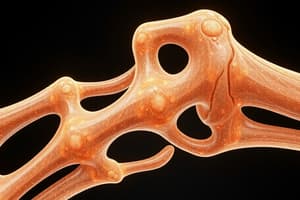Podcast
Questions and Answers
What is the first stage of indirect bone healing?
What is the first stage of indirect bone healing?
- Soft callus formation
- Hematoma formation (correct)
- Hard callus formation
- Remodeling
Which stage of indirect bone healing involves the conversion of the soft callus into a hard callus?
Which stage of indirect bone healing involves the conversion of the soft callus into a hard callus?
- Remodeling
- Hard callus formation (correct)
- Hematoma formation
- Soft callus formation
In the context of bone healing, what does remodeling specifically refer to?
In the context of bone healing, what does remodeling specifically refer to?
- Conversion of cartilage to bone
- Formation of cartilage at the injury site
- Initial blood clot formation
- Final shaping and strengthening of bone (correct)
What distinguishes indirect bone healing from direct bone healing?
What distinguishes indirect bone healing from direct bone healing?
Which of the following stages comes right after soft callus formation in the indirect bone healing process?
Which of the following stages comes right after soft callus formation in the indirect bone healing process?
What does the term 'fracture' literally mean?
What does the term 'fracture' literally mean?
Which of the following is NOT a way to describe a fracture?
Which of the following is NOT a way to describe a fracture?
Which of these best describes a common consequence of a fracture?
Which of these best describes a common consequence of a fracture?
What is a potential cause of a fracture?
What is a potential cause of a fracture?
Which statement about fractures is accurate?
Which statement about fractures is accurate?
What is the first step in assessing a suspected fracture?
What is the first step in assessing a suspected fracture?
Which of the following assessments is NOT performed when checking vascularity?
Which of the following assessments is NOT performed when checking vascularity?
Which nerve is assessed alongside the ulnar and median nerves during a fracture examination?
Which nerve is assessed alongside the ulnar and median nerves during a fracture examination?
Which symptom is least likely to indicate a fracture?
Which symptom is least likely to indicate a fracture?
What aspect of vascularity should be assessed in a suspected fracture?
What aspect of vascularity should be assessed in a suspected fracture?
What is the ideal timeframe for surgery if traction is not needed?
What is the ideal timeframe for surgery if traction is not needed?
What is a primary goal following surgery according to the established protocol?
What is a primary goal following surgery according to the established protocol?
What prophylactic measure should be initiated for the patient?
What prophylactic measure should be initiated for the patient?
Which condition should the patient be evaluated for after discharge?
Which condition should the patient be evaluated for after discharge?
Why is immediate ambulation important after surgery?
Why is immediate ambulation important after surgery?
What happens to arterioles in the circulatory system?
What happens to arterioles in the circulatory system?
What is the primary role of capillaries in the circulatory system?
What is the primary role of capillaries in the circulatory system?
What characterizes the walls of capillaries compared to other blood vessels?
What characterizes the walls of capillaries compared to other blood vessels?
What process occurs at the site known as 'Capillary Fill'?
What process occurs at the site known as 'Capillary Fill'?
What do capillaries become after their function in gas exchange?
What do capillaries become after their function in gas exchange?
Flashcards are hidden until you start studying
Study Notes
Indirect Bone Healing
- Occurs through the formation of cartilage as an intermediate stage.
- Proceeds in four stages: Hematoma formation, Soft callus formation, Hard callus formation, and Remodeling.
Direct Bone Healing
- Occurs after surgical intervention.
- May be associated with hardware failure.
Fracture
- Refers to a broken bone.
- Can be described clinically based on:
- Symptoms and signs of fracture.
- Skin integrity.
- Compartment status of the forearm.
- Nerve function (Ulnar, Median, and Radial).
- Vascular status (color, temperature, capillary refill, and pulse).
Fracture Management
- Surgery is recommended within 48 hours.
- Early ambulation is encouraged.
- DVT prophylaxis should be initiated.
- Evaluation for osteoporosis is required after discharge.
Capillary Fill
- Arterioles transition into capillaries, which then transition into venioles.
- The thin vessel walls at this point facilitate oxygen and material exchange.
Studying That Suits You
Use AI to generate personalized quizzes and flashcards to suit your learning preferences.




